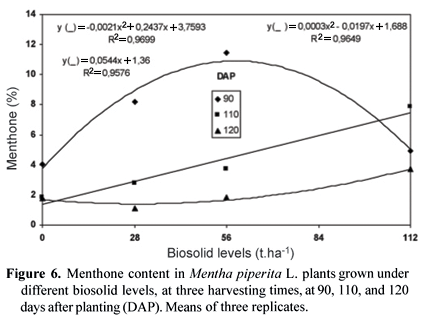This research evaluated the effects of biosolid levels on yield and chemical composition of Mentha piperita L. essential oil. Mint plants were grown in a greenhouse in pots containing the equivalent to 0, 28, 56, and 112 t.ha-1 biosolid. Three evaluations were made at 90, 110, and 120 days after planting (DAP). The oil was extracted from the dry matter of shoots by hydrodistillation, and composition was determined by GC/MS. Oil production was slightly affected by the biosolid, increasing when plants were grown with 28 t.ha-1, a condition which did not result in quality improvement. Menthyl acetate was the component obtained at the highest percentage in all treatments. At 90 DAP, plants showed a higher percentage of menthol, the second-highest oil constituent, with a content of 42.3% in plants grown without biosolid. The presence of biosolid favored menthofuran formation. As with menthol, menthone decreased with plant development. Under these conditions, plant harvesting is recommended at 90 DAP, period in which the menthol level was higher. Since the production of biosolid is on the rise, a suitable destination must be given to it, and restrictions exist for its use in relation to the environment and plants. Thus, although cultivation with 28 t.ha-1 is within the limits allowed by law, such a rate, which increased oil yield, did not improve oil quality. Therefore, biosolid from the Barueri Station is not recommended for cultivation of this specie.
menthol; menthyl acetate; peppermint; sewage-sludge










